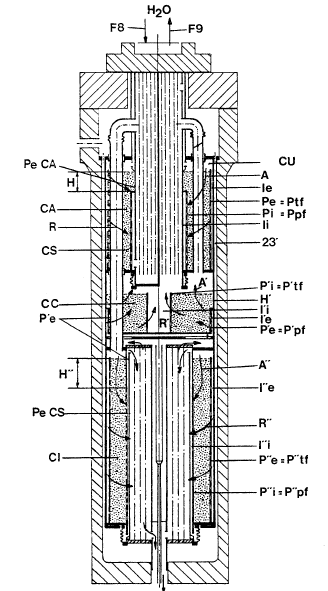Note: Descriptions are shown in the official language in which they were submitted.
DESCRIPTION
___________
This invention concerns the improvements made to reactors for
heterogeneous synthesis. It concerns more particularly a
system to increase the yields of reactors for heterogeneous
synthesis and more particularly for the synthesis of ammonia,
comprising a catalytic layer partly connected to a boiler, a
catalytic layer substantially run through by a heat
exchanger, and at least one intermediate catalytic layer.
Reactors of the type described above are known per se and are
the object of Italian patent No. 28961-66.
In order to establish matters straight away and to ma~e it as
easy as possible to understand the invention, Figure
(partial cross-section with a plan showing the reactor's
axis) outlines a reactor design according to the patent in
question.
The synthesis gas GS enters from 10, flows from top to bottom
through airspace 21 between the internal wall 22 of the shell
M and the external wall 23 of the cartridge CU, flows upwards
from the bottom FO (following arrow F1) running through the
inside of tubes Ti of the heat exchanger SC, flows axially
(arrow F2) through the intermediate catalytic layer CC, is
cooled in the first branch of the boiler CA from the top of
which it leaves in order to penetrate (arrow F3) the top
~' I
catalytic layer CS, t~rough which it runs axially from top to
bottom leaving according to arrow F4 and flowing again
upwards as ~'4 which enters tube sP which takes it as ~low F5
directly into the lower catalytic layer CI from which it
flows as F ' 5 to continue upwards inside exchanger Sc from the
top of which it is sent downwards as F7 flowing through
central tube 25' and leaving this as reacted gas F'7.
Arrow F8 indicates the conduction of water to the boiler and
arrow F9 indicates the exit from the boiler of the vapour
produced therein by recovering reaction heat. Since the
reactor in question is known it is not described in detail
herein, such description belng available in the above-
mentioned Italian patent No. 28961-66.
Reactors of the type déscribed above, although already
remarkably improved when compared to the technology available
up to the moment when they made their appearance, suffered
from a nu~ber of disadvantages which in the long run became
an obstacle to the success which it seemed reasonable to
expect from them.
Among the disadvantages in quéstion, mention should be made
in particular of those connected with the axial flow of the
synthesis gas through the catalytic beds, of the ensuing
pressure drops and of the need to use a large size catalyst
in order to limit the pressure drop in question.
characterized by the fact that in the intermediate calalytic
layers unconnectd to the boiler or to the heat exchanger, the
annular wall forming an airspace with the cartridge is the
external one and is perforated along a shorter length than
the annular internal wall, the cylindrical space inside said
annular wall with the greater perforated length being free
from catalyst, constituting the second airspace.
The invention obviously comprises the reactors as
obtained with the system in question.
The invention will now be described by way of example
and reference to the accompanying drawings in which:
Figure 1 shows a cross-sectional view of a known
reactor.
Figure 2 shows a cross-sectional view of a reactor in
accordance with the invention.
A preferred but not limitative embodiment of the
invention is shown in Figure 2, which is a longitudinal
partial cross-section, similar to that in Figure 1, of a
reactor converted from being totally axial to being
substantially radial.
According to a first aspect of the invention, two
airspaces are created in each catalytic bed, one of these,
i.e., still the external one Ie, I'e, I"e, always involves
the internal wall 23' of the cartridge CU. In ePfect the
annular external walls Pe, P'e, P"e are introduced into the
three beds to form said external airspaces Ie, I'e, I"e with
23'. Into the same beds are introduced annular internal
walls Pi,P'i, P"i which form the internal airspaces Ii, I'i,
I"i.
According to an aspect of the invention, in the two end
beds connected to the boiler ~top bed CS) and to the heat
exchanger (bottom bed CI), the external walls Pe and P"e are
totally perforated so that Pe = Ptf and P"e = P"tf (where Ptf
stands for totally perforated wall). The corresponding
internal wall Pi and P"i are unperforated for a minor portion
H, respectively H". Preferably, the unperforated section H
consists of the boiler's external wall Pe CA. In the bottom
bed CI too, the unperforated wall H" can be the external wall
Pe CS of the heat exchanger. Preferably however, the sectlon
H" is the unperforated continuation of internal wall Pi"
which coincides therefore with the partly perforated wall
P"pf (pf = partly perforated).
According-to another aspect of the invention, an
external annular wall P' unperforated along section H' is
introduced into the intermediate bed, said section H' being
formed by the solid wall 23' of the cartridge. The internal
annular wall P'i is perforated for its total length,
therefore P'i = P'tf. The cylindrical wall inside P'i, i.e.,
the internal airspace I'i, is now empty, i.e., not filled
with catalyst.
By arranging in each bed a totally perforated wall
accompanied by a partially perforated wall the axial flow A,
A', can be achieved, respectively A", in the minor
unperforated portions H, H', respectively H", and a radial
flow in the remaining major perforated portions in the single
beds.
Thanks to this , it is now possible to use a small-
size catalyst thus reducing further pressure drop and
increasing yields.
The applicants have in effect already described in a
series of preceding patents and patent applications, the
advance technology of their axial-radial reactors; see in
particular, U.S.A. Patent No. 4,372,920.
